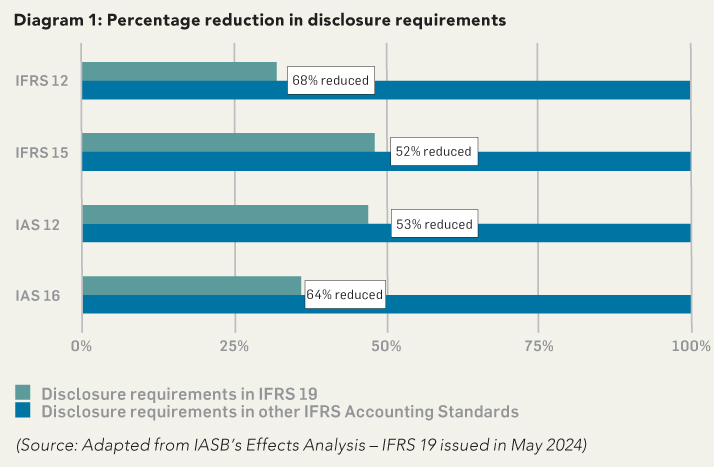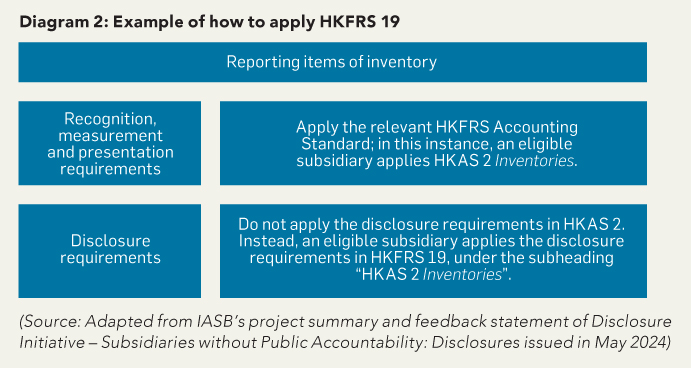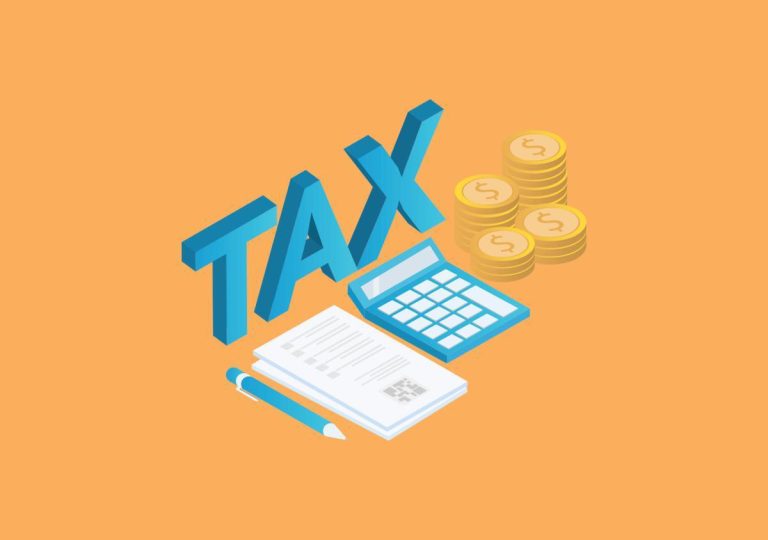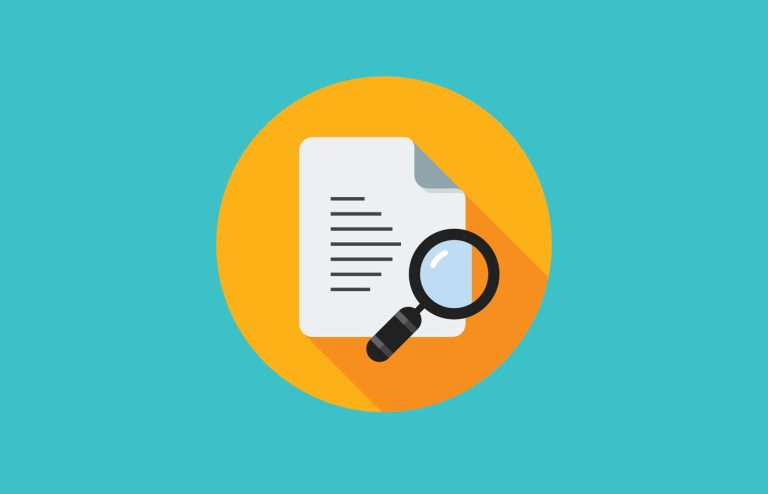On 29 July, the Hong Kong Institute of CPAs issued Hong Kong Financial Reporting Standard (HKFRS) 19 Subsidiaries without Public Accountability: Disclosures, the equivalent of International Financial Reporting Standard (IFRS) 19 issued by the International Accounting Standards Board (IASB). HKFRS 19 is a disclosure-only standard which allows eligible subsidiaries to apply HKFRS Accounting Standards with reduced disclosure requirements. It does not include recognition, measurement and presentation requirements. Those requirements in other HKFRS Accounting Standards remain applicable.
An eligible subsidiary may elect to apply HKFRS 19 in its consolidated, separate or individual financial statements for reporting periods beginning on or after 1 January 2027. Earlier application is permitted.
Who can apply HKFRS 19?
HKFRS 19 is a voluntary standard for eligible subsidiaries. A subsidiary is eligible if:
- It does not have public accountability; and
- Its ultimate or intermediate parent produces consolidated financial statements available for public use that comply with HKFRS Accounting Standards.
A subsidiary has public accountability if:
- Its debt or equity instruments are traded in a public market, or it is in the process of issuing such instruments for trading in a public market; or
- It holds assets in a fiduciary capacity for a broad group of outsiders as one of its primary businesses (for example, banks, credit unions, insurance companies, securities brokers/dealers, mutual funds and investment banks often meet this second criterion).
Expected benefits and costs of HKFRS 19
Addressing dual reporting challenges
In Hong Kong, certain subsidiaries prepare their annual statutory financial statements using Small and Medium-sized Entity Financial Reporting Framework and Financial Reporting Standard (SME Standard) or HKFRS for Private Entities. At the same time, these subsidiaries also need to prepare a group reporting package in HKFRS Accounting Standards for their parents for the purpose of preparing the group’s consolidated financial statements. These subsidiaries generally need to maintain additional accounting records or prepare additional information for group reporting purposes because of the recognition and measurement differences between different sets of accounting standards.
Applying HKFRS 19 will enable these subsidiaries to use the group’s accounting policies in preparing their own financial statements without being subject to the full disclosure requirements in HKFRS Accounting Standards. This will eliminate the complications of dual reporting and the associated costs of keeping at least two sets of accounting records, thereby allowing the subsidiaries and their groups to simplify their reporting systems and processes.
Getting rid of disproportionate disclosure requirements
Subsidiaries that apply HKFRS Accounting Standards in preparing their annual statutory financial statements will also benefit from applying HKFRS 19. Although these subsidiaries do not have the problems of dual reporting, they may find applying HKFRS Accounting Standards unappealing because the disclosure requirements in HKFRS Accounting Standards are designed for publicly accountable companies and are disproportionate to the information needs of the users of these subsidiaries’ financial statements. Applying HKFRS 19 would eliminate the need for these disproportionate disclosures and the associated time and costs in preparing and auditing those disclosures.
The IASB has assessed the reduction in disclosure requirements for a sample of IFRS Accounting Standards to illustrate the potential effects of applying IFRS 19. Diagram 1 below shows the results of the assessment. The percentage reduction was calculated by comparing the number of disclosures under a subheading in IFRS 19 and those in the respective IFRS Accounting Standard.
Benefits will vary
The benefits of adopting HKFRS 19 will vary depending on the facts and circumstances of the companies, such as:
- The accounting requirements currently applied by an eligible subsidiary;
- The financial reporting systems and processes within the group;
- The number of subsidiaries within the group that choose to apply HKFRS 19; and
- The size and complexity of the subsidiaries’ operations.
Transition costs
When assessing whether to apply HKFRS 19, companies should also take note of the one-off transition costs that might be incurred on initial application of HKFRS 19. Examples of transaction costs include those relating to changing financial reporting systems and processes, and identifying the disclosure requirements that no longer apply and the information that no longer needs to be gathered and disclosed when applying HKFRS 19. The transition costs will differ from company to company. If a company concludes that the transition costs are not justified, it may choose not to apply HKFRS 19.
How to apply HKFRS 19
An eligible subsidiary that applies HKFRS 19 applies the requirements in other HKFRS Accounting Standards except for the disclosure requirements. Instead, the subsidiary applies the reduced disclosure requirements in HKFRS 19. See Diagram 2 below.
Notwithstanding the above, entities should take note of the following exceptions:
- Subsidiaries eligible to apply HKFRS 19 are not required to apply Hong Kong Accounting Standard (HKAS) 33 Earnings per Share or HKFRS 8 Operating Segments, but may do so voluntarily. If an entity applying HKFRS 19 also voluntarily applies HKAS 33 or HKFRS 8, it is required to apply all the disclosure requirements in those respective standards.
- If an entity applying HKFRS 19 also applies HKFRS 17 Insurance Contracts, it is required to apply all the disclosure requirements in HKFRS 17, as there are no reductions in the disclosure requirements for HKFRS 17 at this stage.
- A new or amended HKFRS Accounting Standard may include disclosure requirements about an entity’s transition to that new or amended standard. Any relief granted to an entity applying HKFRS 19 regarding these transition disclosure requirements will be set out in the new or amended HKFRS Accounting Standard.
An eligible subsidiary applying HKFRS 19 should consider whether to provide additional disclosures if its compliance with the requirements in HKFRS 19 would be insufficient to enable users of its financial statements to understand the effect of transactions, and other events and conditions, on the subsidiary’s financial position, financial performance and cash flows. On the other hand, an eligible subsidiary need not provide the specific disclosure required in HKFRS 19 if such information is not material.
As HKFRS 19 is part of HKFRS Accounting Standards, an eligible subsidiary that applies HKFRS 19 is required to clearly state in its explicit and unreserved statement of compliance with HKFRS Accounting Standards that HKFRS 19 has been adopted.
An eligible subsidiary can opt to revoke its application of HKFRS 19 for future periods. It may also choose to apply the standard again in subsequent periods.
Interaction with HKFRS 1
When an eligible subsidiary prepared its financial statements for the immediately preceding period under SME Standard or HKFRS for Private Entities and elects to apply HKFRS 19 in the current period, the subsidiary is considered a first-time adopter of HKFRS Accounting Standards and the disclosure requirements in HKFRS 19 that relate to HKFRS 1 First-time Adoption of Hong Kong Financial Reporting Standards will apply.
Other subsidiaries that are already applying HKFRS Accounting Standards and moving between applying HKFRS Accounting Standards with HKFRS 19 and HKFRS Accounting Standards without HKFRS 19 would not be within the scope of HKFRS 1.
Implementing HKFRS 19
Application of HKFRS 19 is voluntary. Eligible subsidiaries should evaluate the potential costs and benefits of the new standard as illustrated earlier in this article to decide whether to apply HKFRS 19 to their financial statements. Entities which have decided to apply HKFRS 19 should read the new standard thoroughly to identify the disclosure requirements that no longer apply and the information that no longer needs to be gathered. In addition, entities should adjust their financial reporting systems and processes properly to ensure that they can accommodate the disclosure requirements of HKFRS 19 effectively.
To support the implementation of the new standard, the IASB has provided various technical resources upon the issuance of IFRS 19, such as webcasts and educational materials that introduce IFRS 19, discuss the likely costs and benefits of IFRS 19, and share insights from global preparers and IASB members on the implementation of IFRS 19. The Institute also plans to organize educational sessions in the coming months to help entities understand the main features of the new standard. Stay tuned for these upcoming educational sessions and get in touch with the Institute’s Standard Setting Department through the Technical Enquiry system if there are any questions with implementing HKFRS 19.
This article was contributed by Shiro Lam, Associate Director of the Institute’s Standard Setting Department. Visit our “What’s new” webpage for our latest publications, and follow us on LinkedIn for upcoming activities.


















